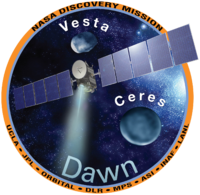
Photo from wikipedia
Abstract We use data collected by the Dawn Gamma-Ray and Neutron Detector (GRaND) at Vesta to map compositions corresponding to nearly pure igneous lithologies in the howardite, eucrite, diogenite (HED)… Click to show full abstract
Abstract We use data collected by the Dawn Gamma-Ray and Neutron Detector (GRaND) at Vesta to map compositions corresponding to nearly pure igneous lithologies in the howardite, eucrite, diogenite (HED) meteorite clan (samples likely from Vesta). At the ∼300-km spatial scale of GRaND measurements, basaltic eucrite occurs on only 3% of the surface, whereas cumulate eucrite and orthopyroxenitic diogenite are not detected. The basaltic eucrite region is generally coincident with an area of the surface with thick regolith, elevated H, and moderate crater density, and may represent the best compositional sample of primordial vestan crust. We observe an absence of pure orthopyroxenitic diogenite terrains in the Rheasilvia basin and its ejecta, an observation corroborated by VIR (0.1%), which suggests the south-polar crust was a polymict mixture of igneous lithologies (howardite) at the time of the Rheasilvia impact, or was a thick basaltic eucrite crust with heterogeneously distributed orthopyroxenitic diogenite plutons. The most dominant igneous composition detected (11% of the surface) corresponds to one of the least-abundant igneous lithologies in the HED meteorite collection, the Yamato Type B diogenites (plagioclase-bearing pyroxenites). The distribution of Type B diogenite is spatially correlated with post-Rheasilvia craters in the north-polar region that are in close proximity to the Rheasilvia basin antipode. This suggests that north-polar Type B plutonism may have been associated with the Rheasilvia impact event. We propose that this was either through 1) uplift of pre-existing plutons at the antipode through focusing of Rheasilvia impact stress, or 2) Rheasilvia impact antipodal crustal melting, creating magmas that underwent fractionation to produce Type B plutons.
Journal Title: Icarus
Year Published: 2017
Link to full text (if available)
Share on Social Media: Sign Up to like & get
recommendations!